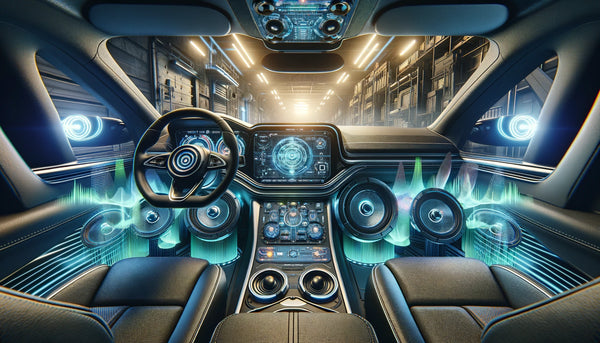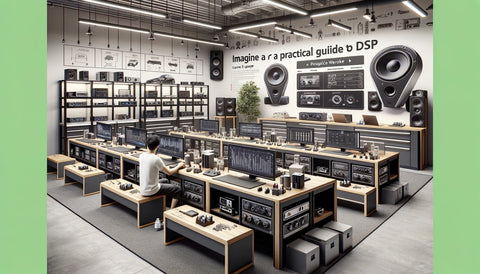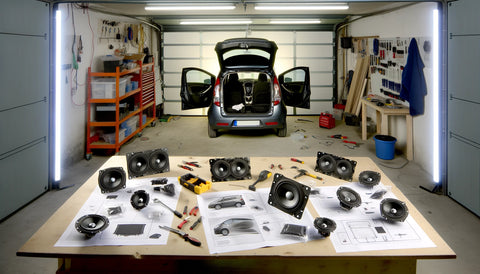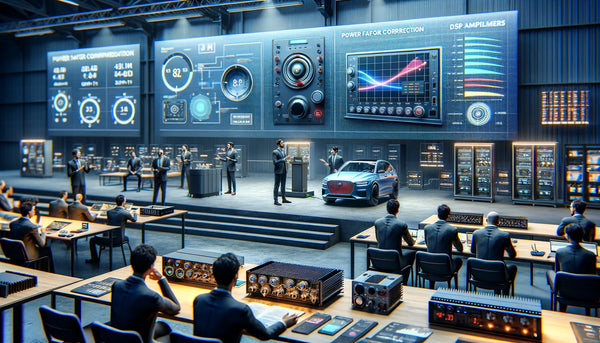Digital signal processing (DSP) power amplifiers are popular in audio amplification. These amplifiers use advanced technology. It improves audio quality, saves energy, and gives precise control over audio signals. Are you a pro sound engineer or an audio fan? Understanding DSP power amps can help you make informed audio setup choices.
This blog will explore the basic concepts of digital signal processing. We will also explain how DSP works in amplifiers. We will discuss the various types of DSP power amplifiers and their benefits. Finally, we will cover their impact on the future of audio. So, let's dive in and unravel the fascinating world of DSP power amplifiers!
Understanding Digital Signal Processing (DSP)

We first need to understand digital signal processing to understand how DSP power amplifiers work. DSP, an abbreviation for digital signal processing, involves manipulating and analyzing digital signals. It uses mathematical algorithms. Analog signals are continuous. Digital signals are discrete. You can control and modify them. DSP allows for efficient processing. It can filter and equalize audio signals. This results in better audio quality and accurate signal reproduction. It is crucial. It plays a key role in audio amplification, ensuring the best performance and quality.
Basic Concepts of DSP
DSP amplifiers, also known as DSP power amps, use digital processing. They turn digital signals into loud sounds. One key aspect of DSP is bit resolution. It determines the clarity and precision of the digital signal. More bits make a more accurate signal. This means better sound. DSP power amplifiers also offer many filter options. These include low pass, high pass, and band pass filters. They allow for more control over the audio.
DSP power amplifiers accept digital audio signals. They skip digital-to-analog conversion. The amplifier processes and boosts the digital signal. This happens within the amplifier itself. This eliminates the signal degradation that can occur with analog amplification.
Digital signal processing in amplifiers offers the ability to manipulate audio signals. This is one of its primary advantages. DSP allows for the use of many audio-processing techniques. These include equalization, crossover control, and dynamic range compression. They use them in real-time. This makes sure the loud audio matches the desired sound. It leads to better sound. Also, DSP power amps can store and load presets. This allows for easy, specific crossover control for different speaker models.
How DSP Works in an Amplifier
DSP power amplifiers integrate digital signal processing technology into the amplifier itself. This integration allows for a smooth signal flow. It enables precise control over the audio signal at different stages of amplification.
The digital signal processor is in the amplifier. It gets the digital audio input and processes it. It uses the predetermined settings and user-defined parameters. The processing includes equalization. It also has crossover control and other audio techniques. These techniques optimize the audio signal for amplification.
The system processes the audio signal. Then, it sends it to the digital amplification stage. Here, we convert the digital audio signal to analog. Then, amplify it to the desired power. The processor monitors the audio signal. It makes real-time adjustments to keep audio quality high and prevent distortion.
DSP power amplifiers offer several benefits. They improve audio quality by using digital signal processing. DSP technology allows for precise control over audio. It ensures accurate equalization, crossover, and dynamic range. This level of control improves audio. It results in better sound with less distortion.
Various Types of DSP Power Amplifiers

Now we know how DSP works in amplifiers. Let's explore the types of DSP power amplifiers in the market. These amplifiers come in different configurations, each catering to specific audio requirements.
One common type is the digital amplifier with DSP. It combines digital amplification with digital signal processing. These amplifiers offer compact designs, high power output, and advanced audio tuning options.
Another popular type is the multi channel amplifier. It provides many channels for amplifying audio signals. Professional audio setups use these amplifiers. Precise control over audio distribution is essential in these setups. They come in various power levels. This allows for customization based on the audio system's needs.
Classifications of DSP Amplifiers
DSP amplifiers can be classified based on channel amplifier configurations. One notable classification is the 4-channel amp with DSP, which offers four channels for audio amplification. These DSP power amplifiers are ideal for audio systems that require separate amplification for multiple speakers or zones. They provide flexibility and control over audio output, making them well-suited for applications such as home theaters, commercial venues, and sound reinforcement systems. Another classification is the single-channel (1 ch) DSP amplifier, also known as a monoblock amplifier. This amplifier is designed to power a single speaker or subwoofer, making it a popular choice for car audio systems.
Power amplifiers with integrated DSP technology provide audio processing capabilities while delivering high power output. These amplifiers utilize digital signal processing to enhance audio quality, optimize signal distribution, and protect speakers from damage.
Key Features of Each Type
Let's delve into the critical features of the different types of DSP amplifiers:
Digital Signal Processing Amplifier:
- Compact design with high power output
- Advanced audio tuning options and equalization capabilities
- Digital signal processing for precise control over audio characteristics
- Integration of crossover control, low-pass filters, and parametric EQ for optimal sound customization
Best 4 channel amp with DSP:
- Four-channel amplification for versatile audio distribution
- Precise control over channel configuration, equalization, and crossover points
- Enhanced audio tuning options for individual speakers or zones
- Advanced signal processing for improved audio quality and clarity
- Power amplifier with integrated DSP:
- High power output with efficient amplification
- Built-in signal processing for precise equalization and crossover control
- RMS power measurement for accurate amplification levels
- Protection circuits to prevent speaker damage and ensure system longevity
These key features make each DSP power amplifier a valuable tool for audio professionals, enthusiasts, and anyone seeking to enhance their audio experience. Whether you require precise audio tuning or high-power output, DSP amplifiers offer a range of options to cater to your specific audio amplification needs.
Benefits of Using DSP Power Amplifiers

Using DSP power amplifiers in audio systems offers several significant benefits. Let's explore some of the key advantages:
- Enhanced Audio Quality: DSP power amplifiers leverage digital signal processing technology to optimize audio quality. They control various audio characteristics precisely, allowing for customized sound reproduction with minimal distortion.
- Energy Efficiency: DSP power amplifiers are designed to maximize energy efficiency without compromising audio performance. Their advanced digital amplification techniques ensure optimal power utilization, reducing energy consumption and costs.
Audio Quality Improvements with DSP
Using DSP power amplifiers offers a central benefit. It is their significant improvement in audio quality. These amplifiers harness digital signal processing. They allow precise equalization, crossover control, and other audio tuning options. These features enhance audio reproduction.
DSP power amplifiers enable audio systems to play low frequencies more. They provide more defined bass. This ensures balanced audio. It reproduces the full range of frequencies, from low to high.
DSP power amplifiers enhance the representation of high frequencies. This results in crisp, detailed sound. Digital signal processing can make precise equalization adjustments. It can address room acoustics, speaker traits, and personal audio preferences.
DSP power amplifiers use digital signal processing with a digital input. This allows efficient equalization control. It ensures audio signals are finely tuned for specific audio needs. They compensate for room acoustics and speaker deficiencies. They also tailor audio to personal preferences. DSP power amplifiers have the tools for great audio.
Energy Efficiency and DSP Amplifiers
Using DSP power amplifiers in audio systems has another key advantage: energy efficiency. These amplifiers deliver high power output while minimizing energy consumption through their design.
A DSP power amplifier incorporates digital amplification technology. It optimizes power use for the most efficiency. Traditional analog amplifiers can generate much heat and waste energy. In contrast, DSP power amplifiers deliver power with better efficiency. They reduce dissipation and energy costs.
DSP power amplifiers have digital signal processing capabilities. They allow for precise control over power output. This control ensures efficient energy use without compromising audio performance. These amplifiers cut waste. They make audio setups greener and more sustainable.
DSP power amplifiers are often energy efficient. They also have advanced power management systems, including power factor correction (PFC). PFC technology makes sure the amplifier draws power from the main supply well. It reduces voltage fluctuations and ensures stable power delivery. This improves audio. It also lengthens the audio system's life by giving it a steady power supply.
Using DSP power amplifiers in audio systems improves audio. They also save energy. They are a valuable addition for audio pros and fans. They want top audio with minimal environmental impact.
The Role of PFC in DSP Amplifiers

Power Factor Correction (PFC) plays a vital role in improving the performance of DSP amplifiers. PFC technology makes sure the amplifier draws power from the main supply well. It optimizes power use and minimizes voltage changes.
DSP power amplifiers have integrated PFC circuits. They maintain a high power factor. This factor is the ratio of real power consumed to apparent power supplied. This improves power efficiency and reduces power consumption. It also enhances voltage stability. This leads to better audio and reliable audio system operation.
Understanding Power Factor Correction (PFC)
PFC is a technology used in power amplifiers. This includes DSP amplifiers. It improves power efficiency and reduces power distortion. It ensures that power from the main supply matches the voltage waveform. This results in optimal power use.
In audio amplifiers, PFC technology corrects the power factor. It adjusts the input current to align with the input voltage. This alignment reduces power distortion. It also minimizes harmonic distortion (THD) and maximizes power transfer efficiency.
DSP power Amplifiers with PFC circuits have a high power factor. This helps them transfer power reliably. It ensures voltage stability and consistent audio quality. PFC technology also protects against voltage fluctuations. It stops potential damage to amplifiers or audio systems from irregular power.
PFC technology enhances power efficiency. It also helps audio amplifiers comply with regulatory standards for power quality. It ensures that amplifiers operate efficiently. They use little power, reducing waste and harm.
Why is PFC Essential in DSP Amplifiers?
Integrating Power Factor Correction (PFC) in DSP amplifiers is essential for several reasons:
- Enhanced Efficiency: By correcting power factor, DSP amplifiers with PFC achieve high power transfer efficiency, maximizing the utilization of available power. This translates into increased amplifier efficiency, reduced power consumption, and optimized energy use.
- Voltage Stability: PFC ensures voltage stability by aligning the input current waveform with the input voltage waveform. This alignment provides a consistent power supply, mitigating voltage fluctuations that can impact audio performance. Stable voltage delivery is crucial for maintaining audio signal integrity and preventing audio distortion.
- Compliance with Standards: DSP power amplifiers with PFC circuits comply with power quality regulations and standards set by organizations such as the International Electrotechnical Commission (IEC). These standards dictate the acceptable power factor range, which ensures efficient power consumption and reduces strain on the power supply.
- Reliable Performance: PFC technology safeguards DSP power amplifiers from power supply irregularities, such as voltage spikes or dips, by providing a stable power factor. This protection enhances the longevity of the amplifier and contributes to reliable audio system operation.
A DSP power amplifier can optimize power efficiency, maintain voltage stability, comply with power quality standards, and deliver high-performance audio amplification by incorporating Power Factor Correction.
How are DSP Power Amplifiers Changing the Future of Audio?

DSP power amplifiers are revolutionizing the audio industry. They do this by pushing the boundaries of audio amps. These amplifiers have digital signal processing. They improve audio quality and offer advanced audio tuning options. They are changing how they reproduce audio.
A DSP power amplifier uses digital signal processing. They offer precise control over audio. This control lets audio pros and fans tailor sound to their tastes and the environment. DSP power amplifiers allow for fine-tuned audio. They have equalization adjustments and crossover control.
Also, DSP power amplifiers use digital converters. These converters improve audio quality. They have high bit resolution and accurate signal reproduction. This ensures faithful audio. It reduces distortion and keeps the original signal.
DSP power amplifiers are driving efficiency and energy conservation in audio. They also improve audio quality. They optimize power use and use power factor correction. This lets them deliver high power while using less energy. This makes them a sustainable choice for audio systems.
Audio's future will likely see more DSP power amplifiers. Many places will use them. These include home theaters, concert venues, recording studios, and commercial sound systems. Digital signal processing technology is advancing and becoming more accessible. DSP power amplifiers will play a big role in shaping audio. They will raise audio quality and offer customizable audio. Wireless DSP programming is now available through apps on iOS and Android devices. This development makes DSP power amplifiers even more versatile and convenient for users.
Frequently Asked Questions

How is a DSP power amplifier different from a traditional power amplifier?
DSP power amplifiers differ from traditional power amplifiers primarily in their signal processing capabilities. While traditional power amplifiers utilize analog circuitry, DSP power amplifiers integrate digital signal processing technology. This digital processing enables precise control over audio characteristics, offering customizable equalization, crossover control, and other audio processing techniques. This advanced technology enhances audio quality, minimizes distortion, and provides energy-efficient power output. On the other hand, traditional analog power amplifiers lack DSP amplifiers' digital signal processing capabilities, resulting in less precise audio control and limited tuning options for subs.
What are the benefits of using a DSP power amplifier in audio systems?
Using a DSP power amplifier in audio systems offers many benefits, including:
- Enhanced audio quality and clarity, thanks to the precise control over audio signals
- You can customize the audio. This lets you tailor it for specific places and preferences.
- Improved energy efficiency, with optimized power use and reduced power consumption
- It has advanced signal processing abilities. These include equalization, crossover control, and dynamic range compression. They result in the best audio performance.
- Protection circuits safeguard speakers and audio components from potential damage. They ensure the longevity of the audio system. You may be setting up a pro sound system, a high-end home theater, or a studio. A DSP power amp can improve your sound.
What types of audio systems can benefit from using a DSP power amplifier?
DSP power amplifiers can benefit various audio systems, including:
- Professional sound reinforcement systems in concert venues, theaters, and live event setups, where precise audio tuning and control are crucial
- Home theater systems, where customization of audio characteristics and accurate signal processing are desired for immersive audio experiences
- High-end stereo systems, where DSP power amplifiers can enhance audio quality, provide crossover control, and offer equalization options for improved sound reproduction
- Recording studios rely on accurate signal processing and precise audio monitoring for high-fidelity audio production. Regardless of the audio system, a DSP power amplifier can elevate audio quality, offering advanced control and refined audio tuning options.
What are the advantages of using a DSP power amplifier in audio systems?
Using a DSP power amplifier in audio systems offers several advantages, including:
- Enhanced audio quality and fidelity, with digital signal processing optimizing signal reproduction for accurate low frequencies, high frequencies, and overall audio response
- Customizable equalization options, enabling precise tuning and correction of room acoustics, speaker characteristics, and personal audio preferences
- Fine control over crossover points, allowing for seamless integration of audio signals between different speakers, resulting in smooth audio transitions and a balanced audio output
- Reliable protection for audio components, with built-in circuits safeguarding against potential damage caused by power fluctuations, excessive voltage, or signal overload
- Energy efficiency, with DSP power amplifiers utilizing power factor correction and digital amplification techniques to maximize power utilization, reduce energy consumption, and minimize heat generation. A DSP power amplifier in audio systems ensures high-quality audio reproduction, customized audio tuning, and optimized energy utilization.
What is the difference between a DSP and a traditional analog power amplifier?
A DSP power amplifier and an analog power amplifier differ in how they process signals. A traditional analog power amplifier operates on analog circuitry. It amplifies audio signals with no digital processing. In contrast, a DSP power amplifier includes digital signal processing technology. This tech gives precise control over audio signals. This digital processing allows for custom equalization and crossover control. It also offers other audio tuning options. These result in better audio, less distortion, and efficient power use. Traditional analog power amplifiers lack the digital signal processing of DSP power amplifiers. This limits their audio tuning and control.
Conclusion
In conclusion, DSP power amplifiers have revolutionized the audio industry. They have advanced digital signal processing. It offers better audio and uses less energy. These amplifiers come in various types. Each type has its unique features and benefits. The inclusion of power factor correction further optimizes their performance.
The future of audio lies in the hands of DSP power amplifiers. They can deliver great sound and save energy. This makes them ideal for many audio systems. They are changing the way we experience sound. This is true in professional settings, live events, and home audio setups. DSP power amplifiers are the cause.
People often ask about DSP power amplifiers. They want to know how they differ from analog amplifiers. They want to know their benefits and the best settings for top performance. DSP power amplifiers are becoming more popular and versatile. It's crucial to stay informed about their potential to elevate your audio experience.
Don't miss out on the ultimate car audio upgrade! Read our DSP amplifier guide now and start enjoying your music like never before.




